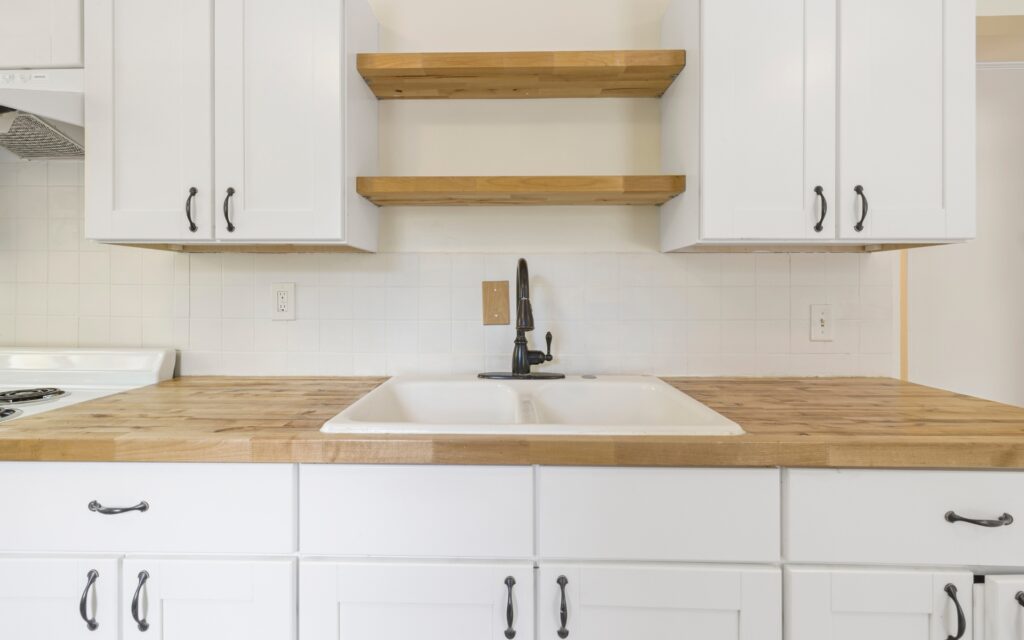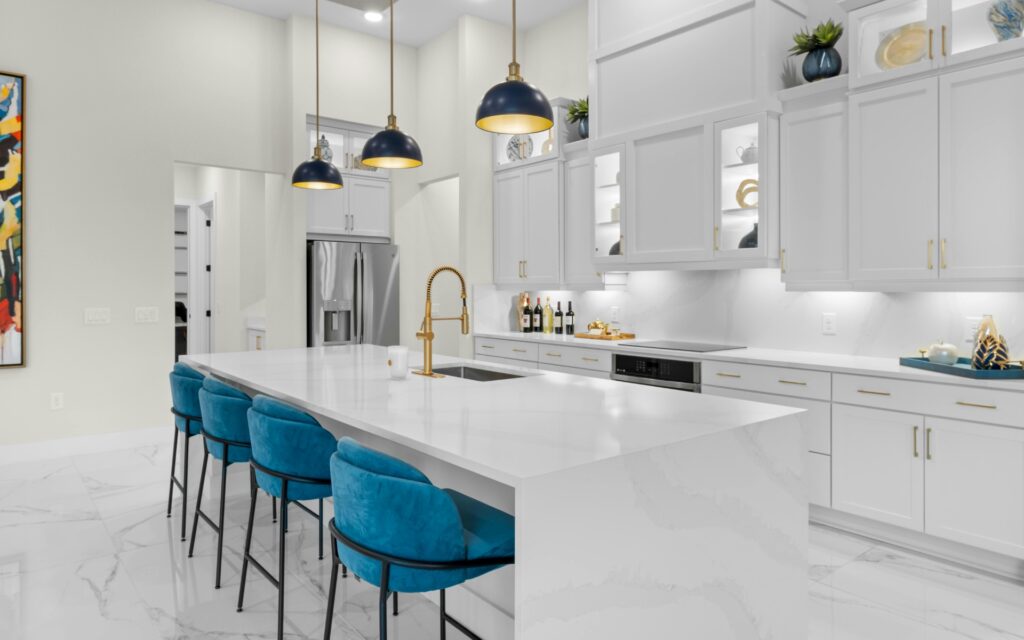When planning a kitchen remodeling, the finish on your cabinets can completely change the mood of your space. The finishes for kitchen cabinets determine how your cabinets look, feel, and age over time. It’s the final layer that protects against moisture, stains, and wear. More importantly, it defines the personality of your space.
Finishes affect the way natural and artificial light interact with the wood. Glossy finishes bounce light around the room, while matte options create a softer, more intimate look. When choosing the best finishes for kitchen cabinets, it’s essential to think about both aesthetics and practicality. According to Houzz, most homeowners consider cabinet finishes one of the top five design decisions during a remodel because it sets the tone for everything else.
10 Awesome Finishes for Kitchen Cabinets
Homeowners often find themselves overwhelmed with options. Once you know the main types of finishes, the process becomes more straightforward. Let’s explore the most common categories and how each one affects appearance and maintenance.
1. Painted Finishes
Because of the practically endless palettes possible with painted cabinets, they continue to rank among the most popular options. The finish provides a smooth, opaque surface that completely hides the wood grain, giving your space a clean and uniform appearance.
Light colors like white, beige, and gray are timeless options, while bold shades such as navy, forest green, or charcoal offer a contemporary twist. A paint finish can make smaller spaces appear brighter and larger.
To ensure a durable surface, professional finishers often apply multiple layers of primer and paint, followed by a protective topcoat. HGTV recommends high-quality acrylic paints for long-lasting results that resist chipping and discoloration.
2. Stained Finishes for Kitchen Cabinets
A stain finish enhances the wood’s natural grain rather than covering it. It highlights the organic patterns that make each cabinet unique. For homeowners who appreciate the character of natural wood, staining is a timeless option.
Stains range from light oak to deep espresso tones. Light stains feel airy and casual, while darker hues create a cozy and dramatic effect. When paired with quality wood species like maple or cherry, stain finishes can give your kitchen a warm, inviting look that ages beautifully.
3. Glazed Finishes
Glazing adds depth and dimension to your cabinets. A glaze is a semi-transparent coating applied over a painted or stained base. It settles into grooves and corners, emphasizing details and craftsmanship.
Homeowners often choose glazed finishes for traditional or transitional kitchen styles because they highlight decorative molding and door panels. A glaze can subtly darken the base color and give it an antique or hand-finished appearance.
4. Natural Finishes
Nothing compares to the beauty of authentic wood tones. A natural finish celebrates the material’s raw texture and variation. It typically includes a clear protective coat that enhances durability while keeping the true color visible.
This option works well in spaces designed around earthy textures, open shelving, or organic-inspired decor. A natural finish is also a great match for eco-conscious homeowners who prefer minimal chemical treatment.
5. Varnished Finishes
A varnish finish combines durability and shine. It’s often applied as a clear, hard coating that seals and protects the surface. Varnished cabinets are highly resistant to moisture and heat, making them ideal for busy kitchens where cooking and cleaning are frequent.
Depending on the level of gloss you choose, varnish can create anything from a subtle sheen to a mirror-like effect.
6. Distressed Finishes
For homeowners who love a timeworn or rustic aesthetic, distressed finishes are a beautiful option. This technique involves lightly sanding edges, adding nicks, or using layered paint to mimic the look of aged wood.
It’s perfect for farmhouse, cottage, or vintage-inspired kitchens where imperfection adds character. When combined with antique hardware, distressed cabinets bring a sense of comfort and nostalgia.
7. Waterborne Finishes
Modern innovations have introduced waterborne finishes. Environmentally friendly alternatives to traditional solvent-based products. They produce low odors, dry quickly, and offer excellent clarity.
A lot of people like that waterborne paints don’t turn yellow over time, so the colour stays the same. They’re ideal for families seeking a safer and eco-conscious choice without compromising on quality or appearance.
8. Specialty Finishes: Laminate, Thermofoil, and Melamine
Some homeowners prefer easy-to-clean surfaces that mimic the look of real wood without the same upkeep. Laminate, thermofoil, and melamine finishes each provide excellent value for money and versatility.
- Laminate uses a thin layer of printed material fused to particleboard or MDF, creating a durable and affordable surface.
- Thermofoil is a vinyl film applied to MDF under heat, resulting in a smooth and seamless look.
- Melamine features a resin-saturated paper fused to particleboard, offering a glossy and scratch-resistant finish ideal for high-traffic kitchens.
These materials come in various colors and textures, making them practical for homeowners who want a modern kitchen remodel or aesthetic with minimal maintenance.
9. Wood Veneer Finishes
If you love the look of solid wood but want a more budget-friendly option, wood veneer cabinets strike a great balance. Veneers use a thin slice of real wood applied to a core panel, giving you the rich grain and texture of natural wood without the higher cost.
They’re lightweight, versatile, and often finished with protective coatings to resist damage. When matched with the right countertop and hardware, wood veneer cabinets deliver a refined, elegant look.
10. Two-Tone Finishes
A two-tone finish brings personality and visual contrast to your kitchen. It’s when cabinets feature two different colors or materials, such as white upper cabinets paired with navy lowers, or wood tones mixed with painted sections.
Designers use this approach to break up uniformity, highlight architectural elements, or add depth to a large kitchen. A two-tone palette works particularly well in open-concept homes where the kitchen connects to the dining or living area.
Choosing the Right Finish for Your Home
When narrowing down finishes for kitchen cabinets, start with your home’s overall style and color palette. Consider lighting, daily wear, and how much time you want to spend on upkeep.
Matte finishes hide fingerprints but may show dirt more easily. Glossy options reflect more light but can highlight imperfections. Textured finishes, such as distressing or glazing, disguise small flaws and add personality.
If you’re planning a complete kitchen transformation, you can explore combinations like painted bases with stained islands or natural wood doors with contrasting frames. These details bring character and balance to your design.
A professional kitchen and bath designer from CabinetLand can help you visualize your options through samples and 3D renderings. It’s a smart move to consult experts before finalizing, ensuring the finish you choose fits your lifestyle and long-term goals.
Maintaining and Protecting Your Cabinet Finishes
Even the most durable finish needs care. Regular cleaning with a mild soap solution helps preserve the luster without damaging the coating. Avoid abrasive scrubbers or harsh chemicals that can dull the surface.
For wood finishes, occasional conditioning with a specialized cleaner helps prevent drying and cracking. Painted or laminated finishes benefit from gentle dusting and soft cloth wipes to remove buildup.
A lasting cabinet finish depends on both the product quality and how well it’s maintained. Using proper ventilation while cooking and wiping spills immediately can extend the life of your cabinets.
When your cabinets begin showing signs of wear, cabinet refinishing might be a cost-effective way to refresh the look without replacing everything. It’s ideal for homeowners wanting a makeover or facelift that saves money compared to a full remodel.
Trends in Kitchen Cabinet Finishes
Cabinet trends evolve every few years, but some styles remain timeless. Many homeowners are moving toward finishes that highlight texture and natural appeal.
Current kitchen cabinetry colors and finishes lean toward soft neutrals, warm wood tones, and muted greens or blues. Matte and satin finishes continue to dominate, providing a modern yet inviting atmosphere.
Designers also notice an increase in demand for waterborne and two-tone finishes, thanks to their mix of sustainability and style. Paired with sleek hardware or mixed materials, these finishes elevate everyday kitchens into statement spaces.
Inspiration and Ideas for Your Next Kitchen Project
Looking through kitchen and bathroom design ideas can spark inspiration for your next project. A dark-stained island surrounded by light-painted cabinets is one example of a standard finish that many homeowners like to complement with bold details.
Pairing natural wood tones with varnish or stain finishes creates a timeless warmth that suits both traditional and modern homes. If your goal is to achieve an entirely new look, consider a makeover that updates cabinet finishes while keeping the existing layout intact.
Final Thoughts
It takes both art and science to choose the right finishes for kitchen cabinets. It’s about knowing how materials work, how light and colour affect things, and making choices that fit your lifestyle.
CabinetLand works with well-known companies like Dakota and Wolf Classic to make it easier to find the appropriate solution for any home. You may have the perfect mix of style and durability in your kitchen with their design skills and competent installation.
For anyone planning a kitchen transformation, exploring new finishes is one of the most rewarding steps. A well-chosen finish not only enhances beauty but also adds long-term value to your home. Connect with CabinetLand today to discover how the right kitchen cabinet finishes can elevate your space. Schedule your free consultation and take the first step toward your dream kitchen.









